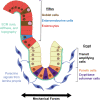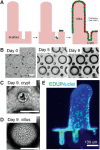In Vitro Models of the Small Intestine: Engineering Challenges and Engineering Solutions
- PMID: 32046599
- PMCID: PMC7462033
- DOI: 10.1089/ten.TEB.2019.0334
In Vitro Models of the Small Intestine: Engineering Challenges and Engineering Solutions
Abstract
Pathologies affecting the small intestine contribute significantly to the disease burden of both the developing and the developed world, which has motivated investigation into the disease mechanisms through in vitro models. Although existing in vitro models recapitulate selected features of the intestine, various important aspects have often been isolated or omitted due to the anatomical and physiological complexity. The small intestine's intricate microanatomy, heterogeneous cell populations, steep oxygen gradients, microbiota, and intestinal wall contractions are often not included in in vitro experimental models of the small intestine, despite their importance in both intestinal biology and pathology. Known and unknown interdependencies between various physiological aspects necessitate more complex in vitro models. Microfluidic technology has made it possible to mimic the dynamic mechanical environment, signaling gradients, and other important aspects of small intestinal biology. This review presents an overview of the complexity of small intestinal anatomy and bioengineered models that recapitulate some of these physiological aspects.
Keywords: gut-on-a-chip; microfluidic models of intestine; small intestine model; tissue engineered intestine.
Conflict of interest statement
No competing financial interests exist.
Figures




References
-
- Shroyer N.F., and Kocoshis S.A.. Anatomy and physiology of the small and large intestines. In: Mahajan, L.A., Kaplan, B., Mahajan, L.A., and Kaplan, B., eds. Pediatr Gastrointest Liver Dis. Philadelphia, PA: Saunders Elsevier, 2011, pp. 324–336.e2
-
- Otterson M.F., and Sarr M.G.. Normal physiology of small intestinal motility. Surg Clin North Am 73, 1173, 1993 - PubMed
-
- Hodde J.P., Badylak S.F., Brightman A.O., and Voytik-Harbin S.L.. Glycosaminoglycan content of small intestinal submucosa: a bioscaffold for tissue replacement. Tissue Eng 2, 209, 1996 - PubMed
Publication types
MeSH terms
Grants and funding
LinkOut - more resources
Full Text Sources

